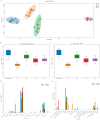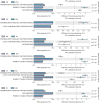The Association between Gut Microbiome Diversity and Composition and Heat Tolerance in Cattle
- PMID: 36014088
- PMCID: PMC9414853
- DOI: 10.3390/microorganisms10081672
The Association between Gut Microbiome Diversity and Composition and Heat Tolerance in Cattle
Abstract
Cattle are raised around the world and are frequently exposed to heat stress, whether in tropical countries or in regions with temperate climates. It is universally acknowledged that compared to those in temperate areas, the cattle breeds developed in tropical and subtropical areas have better heat tolerance. However, the underlying mechanism of heat tolerance has not been fully studied, especially from the perspective of intestinal microbiomics. The present study collected fecal samples of cattle from four representative climatic regions of China, namely, the mesotemperate (HLJ), warm temperate (SD), subtropical (HK), and tropical (SS) regions. Then, the feces were analyzed using high-throughput 16S rRNA sequencing. The results showed that with increasing climatic temperature from HLJ to SS, the abundance of Firmicutes increased, accompanied by an increasing Firmicutes to Bacteroidota ratio. Proteobacteria showed a trend of reduction from HLJ to SS. Patescibacteria, Chloroflexi, and Actinobacteriota were particularly highest in SS for adapting to the tropical environment. The microbial phenotype in the tropics was characterized by an increase in Gram-positive bacteria and a decrease in Gram-negative bacteria, aerobic bacteria, and the forming of_biofilms. Consistently, the functional abundances of organismal systems and metabolism were decreased to reduce the material and energy demands in a hot environment. Genetic information processing and information storage and processing may be how gut flora deals with hot conditions. The present study revealed the differences in the structure and function of gut microbes of cattle from mesotemperate to tropical climates and provided an important reference for future research on the mechanism of heat tolerance regulated by the gut microbiota and a potential microbiota-based target to alleviate heat stress.
Keywords: cattle; fecal microbiome; heat tolerance; regional climates.
Conflict of interest statement
The authors declare no conflict of interest.
Figures






Similar articles
-
Effect of chronic and acute heat challenges on fecal microbiota composition, production, and thermoregulation traits in growing pigs1,2.J Anim Sci. 2019 Sep 3;97(9):3845-3858. doi: 10.1093/jas/skz222. J Anim Sci. 2019. PMID: 31268142 Free PMC article.
-
[Variations of gut microbiome composition under different preservation solutions and periods].Sheng Wu Gong Cheng Xue Bao. 2020 Dec 25;36(12):2525-2540. doi: 10.13345/j.cjb.200475. Sheng Wu Gong Cheng Xue Bao. 2020. PMID: 33398951 Chinese.
-
Characterization of the bacterial microbiota in different gut and oral compartments of splendid japalure (Japalura sensu lato).BMC Vet Res. 2022 May 27;18(1):205. doi: 10.1186/s12917-022-03300-w. BMC Vet Res. 2022. PMID: 35624481 Free PMC article.
-
Invited review: Are adaptations present to support dairy cattle productivity in warm climates?J Dairy Sci. 2011 May;94(5):2147-58. doi: 10.3168/jds.2010-3962. J Dairy Sci. 2011. PMID: 21524505 Review.
-
Perspectives of gene editing for cattle farming in tropical and subtropical regions.Anim Reprod. 2023 Feb 13;19(4):e20220108. doi: 10.1590/1984-3143-AR2022-0108. eCollection 2022. Anim Reprod. 2023. PMID: 36819485 Free PMC article. Review.
Cited by
-
Metagenomic analysis reveals microbial drivers of heat resistance in dairy cattle.Anim Microbiome. 2025 Apr 9;7(1):35. doi: 10.1186/s42523-025-00399-8. Anim Microbiome. 2025. PMID: 40205588 Free PMC article.
-
Gut Microbiota Diversity of Local Egyptian Cattle Managed in Different Ecosystems.Animals (Basel). 2024 Sep 23;14(18):2752. doi: 10.3390/ani14182752. Animals (Basel). 2024. PMID: 39335341 Free PMC article.
-
Microbial communities are thermally more sensitive in warm-climate lizards compared with their cold-climate counterparts.Front Microbiol. 2024 Apr 15;15:1374209. doi: 10.3389/fmicb.2024.1374209. eCollection 2024. Front Microbiol. 2024. PMID: 38686106 Free PMC article.
-
Metabolic pathways associated with Firmicutes prevalence in the gut of multiple livestock animals and humans.Anim Microbiome. 2025 Mar 3;7(1):20. doi: 10.1186/s42523-025-00379-y. Anim Microbiome. 2025. PMID: 40033444 Free PMC article.
-
Faecal microbial diversity in a cattle herd infected by Mycobacterium avium subsp. paratuberculosis: a possible effect of production status.World J Microbiol Biotechnol. 2024 Jul 22;40(9):276. doi: 10.1007/s11274-024-04080-1. World J Microbiol Biotechnol. 2024. PMID: 39037634 Free PMC article.
References
-
- De Rensis F., Marconi P., Capelli T., Gatti F., Facciolongo F., Franzini S., Scaramuzzi R.J. Fertility in postpartum dairy cows in winter or summer following estrus synchronization and fixed time AI after the induction of an LH surge with GnRH or hCG. Theriogenology. 2002;58:1675–1687. - PubMed
-
- Mishra S.R. Significance of molecular chaperones and micro RNAs in acquisition of thermo-tolerance in dairy cattle. Anim. Biotechnol. 2020;29:1–11. - PubMed
-
- Correia Sales G.F., Carvalho B.F., Schwan R.F., de Figueiredo Vilela L., Moreno Meneses J.A., Gionbelli M.P., da Silva Ávila C.L. Heat stress influence the microbiota and organic acids concentration in beef cattle rumen. J. Therm. Biol. 2021;97:102897. - PubMed
Grants and funding
- N.A/Hainan Innovation Center for Academician of Jin Ningyi
- ZY2022HN09/Special Funding Projects for Local Science and Technology Development Guided by the Central Committee
- 322QN24/Youth project of Hainan Natural Science Foundation
- KYQD(ZR)-22006/research start-up project of high-level talent introduction in Hainan University
- N.A/Hainan Innovation Center for Academician of Zhang Yong
LinkOut - more resources
Full Text Sources
Medical

